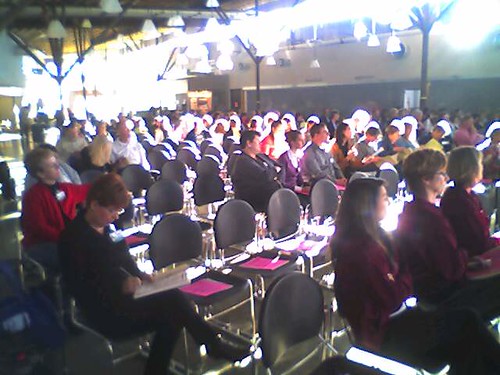The conference is just getting started
Originally uploaded by David Warlick.
 As you can see, light was an issue in the presentation room. It was a commons area at a very impressive community college. The technical staff there went to heroic effors to make sure that everything happened and that I had light (video), sound (house sound for the computer) and information (Internet). Again, there was too much light, as you can tell from the picture. For the two hours leading up to the keynote, the sun was shining directly across the ceiling-mounted screen. At 8:40, when the address began, the streak of sun light only covered the bottom one foot wide, lower left corner of the screen. But it was shining directly in my eyes. Such are the adventures of public speaking.
As you can see, light was an issue in the presentation room. It was a commons area at a very impressive community college. The technical staff there went to heroic effors to make sure that everything happened and that I had light (video), sound (house sound for the computer) and information (Internet). Again, there was too much light, as you can tell from the picture. For the two hours leading up to the keynote, the sun was shining directly across the ceiling-mounted screen. At 8:40, when the address began, the streak of sun light only covered the bottom one foot wide, lower left corner of the screen. But it was shining directly in my eyes. Such are the adventures of public speaking.
The conference staff were wonderful to work with, and the audience was totally hospitable and patient about the problems seeing the slides. They sure keep their sun turned up high in Arizona.
One item that I hope to blog about in more detail later is a product called Development Lab: Educational Virtual Reality Authoring Studio. I had dinner with the AzTEA conference committee the night before, along with a number of exhibitors, and sat next to Scott Jochim, the CEO of the product’s producer, Digital Tech Frontier. We didn’t talk long, because he sat to my right, my deaf zone, but what I learned was intriguing.
He never mentioned Virtual reality, but talked about a tool that allowed students (and teachers) to produce, what they called, virtual vacations. Students could take photographs of a place, and integrate them into a presentation of sorts, that included movement in some way. Again, I didn’t get a clear image of the product, but was especially impressed with the fact that they could share their virtual vacations with other classes in other parts of the world.
Unfortunately, Scott’s presentation was at the same time as one of mine, but I stopped by his room, before hand, and became double intrigued, when I saw a head mounted VR display as part of his exhibit. Evidently, $6,500 gets you the software, a Mac iBook, a nice looking digital camera, with fish eye lens, and a head mounts VR display with integrated audio head set. He showed me a quick demo. Basically, it gives you a cube, upon which you attache six images of your location (north, south, east, west, up, and down). Using the fish-eye lens, you take two (this is all coming from memory, and I was stressed to get back to my presentation room). The software then stitches the images into a fully immersive VR location. I don’t know where you can go from their, but possibilities are endless.
I’ve often suggested that classes take cameras with them on field trips and take 360o worth pictures and using stitching software to create Quicktime VR presentations. But this software seems to do that and a whole lot more.
I hope to have more to say on this later.
